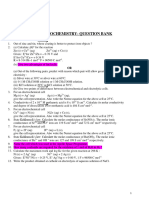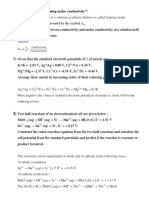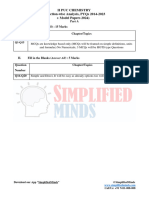Assignment Electro Chemistry 2024-25
Assignment Electro Chemistry 2024-25
Uploaded by
akshatdas08Copyright:
Available Formats
Assignment Electro Chemistry 2024-25
Assignment Electro Chemistry 2024-25
Uploaded by
akshatdas08Original Title
Copyright
Available Formats
Share this document
Did you find this document useful?
Is this content inappropriate?
Copyright:
Available Formats
Assignment Electro Chemistry 2024-25
Assignment Electro Chemistry 2024-25
Uploaded by
akshatdas08Copyright:
Available Formats
CHAPTER 2 ELECTRO CHEMISTRY
1.Define Electrochemical cell.What happens when applied external opposite
potential becomes greater than EO cell of electrochemical cell.
2. Write the Nernst equation and emf of the following cells at 298K:
a) Mg(s)/Mg2+(0.001M)//Cu2+(0.0001)/Cu(s); EoCu2+/Cu = +0.34V, EoMg2+/Mg = -2.36
b) Fe(s)/Fe2+(0.001M)//H+(1M)/H2(g)/Pt(s) EoFe2+/Fe= -0.44 V
3. Calculate the emf of the cell at 25oC for the following :
a) Mg(s) + 2Ag+(0.0001M)→ Mg+2(0.130M) + 2Ag(s). if Eocell =3.17V.
b) Ni(s) + 2Ag+ (0.002M)→ Ni+2(0.160M) + 2Ag(s),Given Eocell =1.05 V
4. Define conductivity,molar conductivity &. limiting molar conductivity.
5. Express the relation among the cell constant ,the resistance of the solution in the cell and the
conductivity of the solution .How is the conductivity of a solution related to its molar conductivity.
6. The resistance of 0.01M NaCl solution at 25oC is 200 ohm.The cell constant of the conductivity
cell is unity .calculate the molar conductivity of the solution.
7. The conductivity of 0.20M solution of KCl at 298 K is 0.0248 S Cm-1.Calculate its
molar conductivity. ( Ans = 124 S cm2 mol-1)
8. The Molar conductivity of a 1.5M solution of an electrolyte is found to be 138.9
Scm2 mol-1 . Calculate the conductivity of this solution.
9. The resistance of conductivity cell containing 0.001M KCl at 298K is 1500 ohm.
What is cell constant if conductivity of 0.001M KCl at 298K is 0.146X 10-3Scm-1.
10. When a certain conductance cell was filled with 0.1M KCl solution it has resistance of 85 ohm
at 25oC.When the same cell was filled with an aqueous solution of 0.052M of unknown
electrolyte the resistance was 96 ohm. Calculate the molar conductivity of electrolyte.
The conductivity of 0.1 M solution of KCl is 1.29 x 10-2Scm-1.
11. The electrical resistance of a column of 0.05 molL-1 NaOH solution of diameter 1 cm and length
50 cm is 5.55 X 103 ohm. Calculate its resistivity, conductivity & molar conductivity.
12. State Kohlrausch law and its application. Limiting molar conductivity of NaCl, HCl and NaAc are
126.4, 425.9 &91 SCm2 mol-1.Calculate Limiting molar conductivity of HAc.
13. Calculate the degree of dissociation of acetic at 298K,given that Λ m(CH3COOH)=11.7 SCm2 mol-1 ,
Λ0m(CH3COO-)=40.9 SCm2 mol-1 , Λ0m(H+)=349.1 SCm2 mol-1
14. Conductivity of 0.00241M acetic acid is 7.896 X 10-6 S cm-1. Calculate its molar conductivity. If Λ0
for acetic acid is 390.5 S cm2 mol-1. What is its dissociation constant?
(Ans = Λm =32.76 S cm2mol-1 ,Ka=1.85 x10-5)
15. The molar Conductivity of 0.025 molL-1 methanoic acid is 46.1 S cm2 mol-1. Calculate its degree
of dissociation & dissociation constant. If λ0(H+) is 349.6 S cm2 mol-1 and λ0(HCOO-) = 54.6 S cm2
mol-1. (Ans = degree of disso=0.1140 ,Ka = 3.67 x 10-4 mol-1 L)
16. Why does the conductivity of a solution decrease with dilution?
17. How do you account for molar conductivity of strong (CH3COONa or KCl ) and weak electrolyte
(CH3COOH)with concentration? Plot the graphs also.
19. How much charge is required for following reduction: (i) 1 mol of Al3+ to Al (ii) 1 mol of MnO4- to
Mn2+
20. How much electricity in terms of Faraday is required to produce (i) 20g of Ca from molten CaCl2
(ii) 40g of Al from molten AlCl3
21. How much electricity in terms of Coulomb is required for the oxidation of (i) 1 mol of H 2O to O2
(ii) 1 mol of FeO to Fe2O3
22. A current of 1.50 A was passed through an electrolytic cell containing AgNO 3 solution with inert
electrodes.the Weight of silver deposited was 1.50g.How long did the current flow?
(Molar mass of Ag = 108gmol-1)
23. A solution of Ni (NO3)2 is electrolysed between platinum electrodes using a current of 5
amperes for 20 minutes. What mass of Ni is deposited at the cathode?
24. Calculate the time to deposit 1.27g of copper at the cathode when a current of 2A was passed
through the solution of CuSO4. (Molar mass of Cu = 63.5gmol-1)
25. How many moles of mercury will be produced by electrolyzing 10M Hg(NO3)2 solution with a
current 0f 2.00A for three hours. (Molar mass of Hg = 200.6 gmol-1)
26. Three electrolytic cells A,B,C containing solutions ZnSO 4,AgNO3,and CuSO4 respectively are
connected in series .A steady current of 1.5 amperes was passed though them until 1.45g of silver
deposited at the cathode of cell B.How long did the current flow? What mass of copper and zinc
were deposited? (Molar mass of Zn = 65,Cu = 63.5, Ag = 108 gmol-1
27. Predict the products of electrolysis: (a) An aq. Solution of AgNO 3 with silver electrodes. (b) An
aq. Solution of AgNO3 with platinum electrodes. (c). An aq. Solution of H2SO4 with platinum
electrodes. (d). An aq. Solution of CuCl2 with platinum electrodes. (e) Aqueous sodium bromide (f)
Copper sulphate using inert electrodes (Pt) (g) Molten NaCl (h) Aqueous sodium chloride solution
28. On the basis of E° values, O2 gas should be liberated at anode but it is Cl2 gas which is liberated
in the electrolysis of aqueous NaCl. Explain
29. Classify Primary Cell or Secondary cell: Dry Cell ,Mercury Cell ,Lead Storage Battery Nickel
cadmium cell .
30. Write the name of the cell which is generally used in transistors. Write the reactions taking
place at the cathode and anode of this cell.
31. Write the name of the cell which is generally used in hearing aids. Write the reactions taking
place at the cathode and anode of this cell
32. Write the name of the cell which is generally used in automobiles & inverters?
33. Write the reaction involved in the Lead Storage Battery. What happens when Lead Storage
Battery is recharged?
34. What is Nickel-Cadmium cell.State its one advantage & disadvantage over Lead Storage
Battery.
35. What is Fuel Cell? Explain with diagram & reaction involved in the following cell.Write its
Advantages.
You might also like
- Sulalitha ChemistryDocument52 pagesSulalitha ChemistrySHRITEJA SHASTRY S95% (111)
- Revision - Electrochemistry (Cbse 2023)Document2 pagesRevision - Electrochemistry (Cbse 2023)Sahana BanuNo ratings yet
- Chapter 3 Important QuestionsDocument5 pagesChapter 3 Important QuestionsSukh sainiNo ratings yet
- ElectrochemistryDocument3 pagesElectrochemistryKeshav GuptaNo ratings yet
- ELECTROCHEMISTRYDocument2 pagesELECTROCHEMISTRYayushkumarsinghh03No ratings yet
- Electrochemistry problemsDocument4 pagesElectrochemistry problemsshashwanth017No ratings yet
- 2.electrochemistry QB (2023-24)Document6 pages2.electrochemistry QB (2023-24)Shana Chandran 18083No ratings yet
- Electrochemistry QDocument2 pagesElectrochemistry Qtiwarivaibhav802No ratings yet
- ElectrochemistryDocument5 pagesElectrochemistryNeel SiddhpuraNo ratings yet
- Revision Worksheet 1 On Chapter ElectrochemistryDocument3 pagesRevision Worksheet 1 On Chapter Electrochemistrywww.luciannarikaNo ratings yet
- 12 Electrochemistry Assignment-1Document4 pages12 Electrochemistry Assignment-1Yashraj NarwariyaNo ratings yet
- 12TH Grade Electrochemistry Worksheet-1Document3 pages12TH Grade Electrochemistry Worksheet-1Amen RaipurNo ratings yet
- Electro Chemistry (QB)Document4 pagesElectro Chemistry (QB)Akshith ReddyNo ratings yet
- Chemistry ch-3Document19 pagesChemistry ch-3DeekshaNo ratings yet
- Class 12 Chemistry Chapter 2 Electro Chemistry Extentand Exercise QuestionsDocument18 pagesClass 12 Chemistry Chapter 2 Electro Chemistry Extentand Exercise QuestionsSaraswati maharanaNo ratings yet
- ElectrochemistryDocument2 pagesElectrochemistrySaksham SinghNo ratings yet
- Pratice Test - 2Document2 pagesPratice Test - 2yaxpatel41No ratings yet
- Term - 2 Chemistry: Mahendra KalraDocument28 pagesTerm - 2 Chemistry: Mahendra KalraNishant KumarNo ratings yet
- Electrochemistry 12THDocument12 pagesElectrochemistry 12THaayanNo ratings yet
- Electrochemistry 1Document8 pagesElectrochemistry 1radhikase32No ratings yet
- XIIElectrochemistryDocument3 pagesXIIElectrochemistryAyush KumarNo ratings yet
- 10 FullDocument4 pages10 FullroobanNo ratings yet
- Electrochemistry Past Papers 2022-14Document4 pagesElectrochemistry Past Papers 2022-14Venugopal JujhavarappuNo ratings yet
- Electrochemistry (2010-2024)Document5 pagesElectrochemistry (2010-2024)soofia baufelNo ratings yet
- Electrochemistry: 2 303 G - RtlogkDocument7 pagesElectrochemistry: 2 303 G - RtlogkSnehashis BoseNo ratings yet
- Electrochemistry Past Papers 2022-14Document4 pagesElectrochemistry Past Papers 2022-1410 A Pratyush Dubey50% (2)
- Electrochemistry ProblemsDocument14 pagesElectrochemistry ProblemsExporting WarriorNo ratings yet
- ELECTROCHEMISTRYDocument1 pageELECTROCHEMISTRYsanjarm099No ratings yet
- Unit-3: ElectrochemistryDocument1 pageUnit-3: ElectrochemistrynaivehoomanNo ratings yet
- Electrochemistry AssignmentDocument3 pagesElectrochemistry Assignmentfkgamer4455No ratings yet
- Electrochemistry WorksheetDocument3 pagesElectrochemistry Worksheetvsbackup261No ratings yet
- AssignmentforSundayTest - D24 Jun 2023Document44 pagesAssignmentforSundayTest - D24 Jun 2023aadityabhagchandaniNo ratings yet
- AssignmentDocument2 pagesAssignmenthoney4cocNo ratings yet
- ELECTROCHEMISTRYDocument5 pagesELECTROCHEMISTRYsarahNo ratings yet
- Electrochemistry Board Questions 2010Document4 pagesElectrochemistry Board Questions 2010amone nNo ratings yet
- Electro Chemistry Numericals - 065546Document10 pagesElectro Chemistry Numericals - 065546YOGA SAI GUHANNo ratings yet
- 3589 39 205 Previous University QuestionsDocument3 pages3589 39 205 Previous University Questions24ad083No ratings yet
- ElectrochemistryDocument2 pagesElectrochemistryKuldeep SharmaNo ratings yet
- 1Document19 pages1Ansari SameerNo ratings yet
- Che 323 Problem Set 6: Electrochemistry March 12, 2014 Engr. May V. Tampus ConceptsDocument1 pageChe 323 Problem Set 6: Electrochemistry March 12, 2014 Engr. May V. Tampus ConceptsLouie G NavaltaNo ratings yet
- Revision Test-ElectrochemistryDocument1 pageRevision Test-Electrochemistryitsrayhan.mNo ratings yet
- TEST - 1 ElectrochemistryDocument2 pagesTEST - 1 Electrochemistrycarsk403No ratings yet
- 1370 - 262 - Textbooksolution - PDF 2Document19 pages1370 - 262 - Textbooksolution - PDF 2PushkarsinghNo ratings yet
- NCERT Solutions For Class 12 Chemistry Part 1 Chapter 3Document23 pagesNCERT Solutions For Class 12 Chemistry Part 1 Chapter 3Om PrakashNo ratings yet
- ElectrochemistryDocument6 pagesElectrochemistrytwinkleparmar0064No ratings yet
- ElectrochemistryDocument11 pagesElectrochemistryterabox69333No ratings yet
- Electrochemistry - Numerical WSDocument4 pagesElectrochemistry - Numerical WSrishima sapruNo ratings yet
- ELECTROCHEMISTRY Q BANKDocument7 pagesELECTROCHEMISTRY Q BANKshashwanth017No ratings yet
- Electrochemistry (Physical Assignment)Document4 pagesElectrochemistry (Physical Assignment)Aryan ChaubeyNo ratings yet
- 3 Electrochemistry Assignment 1Document9 pages3 Electrochemistry Assignment 1Unknown GamerNo ratings yet
- Chem Quiz 8Document10 pagesChem Quiz 8Gaurav ShekharNo ratings yet
- Test ElectrochemistryDocument2 pagesTest ElectrochemistryvktiwariNo ratings yet
- 4c09deb6-fe0c-40c3-9fa1-fdc5951497aeDocument51 pages4c09deb6-fe0c-40c3-9fa1-fdc5951497aeaa7411814No ratings yet
- Electrochemistry Uti Module 3Document8 pagesElectrochemistry Uti Module 3arunarajeshwaryNo ratings yet
- IMP ElectrochemistryDocument5 pagesIMP ElectrochemistryShan PanwarNo ratings yet
- Practice ProblemsDocument2 pagesPractice Problemsanon_915449609No ratings yet
- CBSE Class 12 Chemistry Worksheet - ElectrochemistryDocument4 pagesCBSE Class 12 Chemistry Worksheet - ElectrochemistryArya Verma100% (1)
- PhysicsDocument3 pagesPhysics14 SanalNo ratings yet
- CHEMISTRY Holiday Homework - 12-1Document3 pagesCHEMISTRY Holiday Homework - 12-1Ashif AbhasNo ratings yet
- ChemDocument5 pagesChemleqaaelmakkiiiNo ratings yet
- Practice Makes Perfect in Chemistry: Oxidation-ReductionFrom EverandPractice Makes Perfect in Chemistry: Oxidation-ReductionRating: 5 out of 5 stars5/5 (1)
- Sample Paper For ChemistryDocument23 pagesSample Paper For ChemistryAmit joshiNo ratings yet
- Unit 3 ElectrochemistryDocument14 pagesUnit 3 ElectrochemistrySuresh Dasaraddi100% (1)
- ACT Thrissur Plus Two Easy QuestionsDocument23 pagesACT Thrissur Plus Two Easy QuestionsAbin Pm100% (1)
- Allen: Cbse Practice Questions Paper (2021-22) Term-Ii Subject: ChemistryDocument4 pagesAllen: Cbse Practice Questions Paper (2021-22) Term-Ii Subject: ChemistryabcdNo ratings yet
- 1 Pre Board Examination 2020-21 Subject - ChemistryDocument9 pages1 Pre Board Examination 2020-21 Subject - ChemistryBhawesh Kumar SoniNo ratings yet
- ElectroChem ImpDocument17 pagesElectroChem Implinngeshwar BNo ratings yet
- Learning Material Prepared by PGTs (CHEMISTRY) )Document143 pagesLearning Material Prepared by PGTs (CHEMISTRY) )Loid ForgerNo ratings yet
- S Y B SC Syllabus 1Document71 pagesS Y B SC Syllabus 1Dr. Mithil Fal DesaiNo ratings yet
- STD: Xii Preliminary Examination MARKS: 70 DATE: - / - / - Chemistry Duration: 3 HR General InstructionsDocument3 pagesSTD: Xii Preliminary Examination MARKS: 70 DATE: - / - / - Chemistry Duration: 3 HR General InstructionsAniket SainiNo ratings yet
- 11.electrochemistry Q - WatermarkDocument9 pages11.electrochemistry Q - WatermarkScienTechzNo ratings yet
- Hsslive XII Chem-Quick Revision ACT ThrissurDocument23 pagesHsslive XII Chem-Quick Revision ACT ThrissurprateekshadharaniNo ratings yet
- Jam Formula BookletDocument15 pagesJam Formula BookletMoin AnsariNo ratings yet
- Electrochemistry PDFDocument7 pagesElectrochemistry PDFYogesh chandraNo ratings yet
- Previous HSE Questions and Answers of The Chapter "SOLUTIONS"Document97 pagesPrevious HSE Questions and Answers of The Chapter "SOLUTIONS"ABDUL RAZACKNo ratings yet
- Lecture Planner - Physical Chemistry - Lakshya NEET 2025Document2 pagesLecture Planner - Physical Chemistry - Lakshya NEET 2025sarode9422No ratings yet
- Electrochemistry Revision 2022Document2 pagesElectrochemistry Revision 2022HARSH KHILARINo ratings yet
- ELECTROCHEMISTRY (CH-202) (Q & A) 1st MidDocument12 pagesELECTROCHEMISTRY (CH-202) (Q & A) 1st MidAflatur SafaNo ratings yet
- Electrochemistry & Chemical Kinetics TestDocument3 pagesElectrochemistry & Chemical Kinetics Testgaurika midhaNo ratings yet
- Chemistry FormulaeDocument285 pagesChemistry FormulaeBadri MishraNo ratings yet
- Electrochemistry - JEE Mains PYQ 2023 Session 1Document34 pagesElectrochemistry - JEE Mains PYQ 2023 Session 1Jayesh ChouhanNo ratings yet
- Class 12 Chemistry MCQ - CH-2 ElctrochemDocument30 pagesClass 12 Chemistry MCQ - CH-2 Elctrochemnivrutiverma1234No ratings yet
- Conductomeric TitrationDocument12 pagesConductomeric TitrationKoio KumarNo ratings yet
- Hsslive Xii Chem 3. ElectrochemistryDocument20 pagesHsslive Xii Chem 3. ElectrochemistryHakim Abbas100% (1)
- 1 s2.0 S0013468623008186 MainDocument15 pages1 s2.0 S0013468623008186 Mainfoyahov478No ratings yet
- Chemistry Sectionwise Analysis of PYQs (2024)Document5 pagesChemistry Sectionwise Analysis of PYQs (2024)warriorhitesh48No ratings yet
- Aits 3Document16 pagesAits 3KillerpkNo ratings yet
- Electrochemistry 12Document19 pagesElectrochemistry 12Manas ChhabraNo ratings yet
- Electrochemistry (One Shot) - Class Notes - Safal 2.0Document170 pagesElectrochemistry (One Shot) - Class Notes - Safal 2.023btc078No ratings yet
- Chemistry - (1) ELECTROCHEMISTRY - Upto Faradays LawsDocument159 pagesChemistry - (1) ELECTROCHEMISTRY - Upto Faradays LawscbsegirlsaipmtNo ratings yet

























































































